Embryology of the domestic cat
[Translated into English by Karin Sandbergen.]
By A.L. Leipoldt
Reprinted with permission.
(Note by PawPeds: The author talks about trimesters in the pregnancy. In the context of this article, a trimester means a period of three weeks.)
Introduction
Since the beginning of the 19th century, biologists knew that the early developmental stages of the different classes of vertebrates were very much alike and that embryos will only start to become really different from each other at a later stage. Karl Ernst von Baer (1791 - 1876), the most prominent embryologist of that time, formulated a number of universal rules on the basis of these observations. The most well-known is Baer's law and goes: "general characteristics a species shares with other vertebrates appear earlier in the embryo than the characteristics specific to the species in question" (vertebrates are birds, reptiles, fish, mammals, amongst others...).
Thus the development of the limbs of all vertebrates is, in essence, similar and only later on during the development, differences become noticeable between wings, paws, arms and legs. This similarity in development was one of the phenomena that inspired to Charles Darwin the idea that different species of animal, which, amongst others, resemble each other in this manner, have a mutual origin (The origin of species, 1859).
Therefore, embryology is an interesting subject. Especially comparative embryology has already fascinated many people. Of course, the embryos of two different vertebrates can always be distinguished from each at any stage, if only because their DNA does not match. The observations by Darwin and von Baer, that these embryos, as regards their appearance, are so highly alike during their early development, is not only fascinating but gives food for thought, especially to those people, who are of the opinion that there is a huge difference between man and (any other) animal.
Fertilisation of the ovum
The beginning of an embryo's development is coitus, the mating, of course. The cat, different from a human being, for example, is an induced ovulator, the ovulation(s) of a cat only take place during (and as a consequence of) the mating. During mating millions of sperm are ejaculated into the cat's vagina, but only a few hundred of them reach the Fallopian tube. Thanks to coitus one or more ova are released in the female cat (this is called ovulation), which "travel" through the Fallopian tubes to the uterus. Fusion of ova and sperm takes place in the Fallopian tubes. Not every random sperm will fuse with a female cat's ovum, recognition will take place, so that only the sperm of a male cat can form a fertilised ovum (zygote) with the a female cat's ovum. If animal species are very much alike and are closely related as a species, a zygote can be formed by parents, who belong to different animal species.
We will only discuss here what happens to the zygote, whose parents belong to the animal species Felis Domesticus. A cat's zygote is not as quickly formed as in a mammal that ovulates independently from coitus, but it does not last longer than about twenty-four hours. With cats it turned out that 20 to 28 hour after mating, zygotes (fertilised ova) of 13mm on average could be flushed out of the Fallopian tubes.
First trimester of the pregnancy
After a successful fertilisation, the first step is cell division. That one fertilised ovum divides itself through mitosis into two cells. Mitosis is a cell division in which two copies develop that each have the same cell core. Genetically, those cells are identical to each other. In female cats this first division takes place after 60 to 68 hours after coitus. These first cells are called blastomeres. After this first division, there will be a division every 10 to 14 hours. Division will soon become asynchronous, so not every cell will divide if another divides too. It has been established in different kinds of mammals that every one of the cells has the complete ability to grow into a full-term individual at the two-cell or four-cell stage. Identical "real" human twins are formed by the separation of two cells after the very first division. Very rarely, but it seems to happen, identical quadruplets occur in humans.
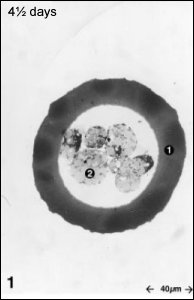 |
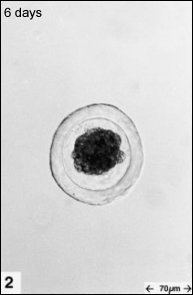 |
After the four-cell stage, not all cells are "totipotent" anymore. Therefore, identical (monozygotic) octuplets will not occur. Divisions continue, there will be more and more cells. This stage is called the cleavage stage, because little growth takes place, only division (the embryo does not grow yet). Of course, the amount of nuclear material will increase, because every new cell has a nucleus. The lump of cells consisting of blastomeres is called a blastomerula. There are approximately 30 cells that form a sphere, four days after fertilisation. This is called the morula, "mulberry". The diameter is virtually the same as the diameter of the blastomerula.
After about six days, the so-called blastula develops by forming a cavity, surrounded by 60 to 80 cells, which are 0.6mm in diameter. This cavity is the beginning of what will later become the digestive tract. The outer cells of the blastula are called trophoblast; these cells are the beginning of the placenta. In humans, implantation of the embryo takes places in the uterine wall at the end of the first week. Whether this moment also applies to cat embryos, I do not know.
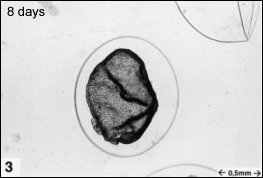 |
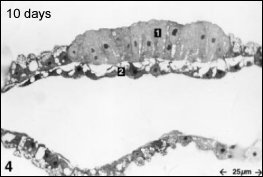 |
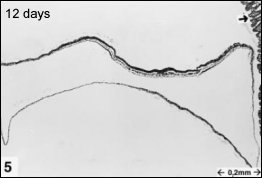 |
Before that time, trophoblasts produce gonadotropin, a hormone that ensures that the endometrium is ready for implantation of the embryos. The embryos have nestled themselves for the next, very important phase: gastrulatio. Gastrulatio is an exceptional process. Different zones of the blastula fold, and form three more or less distinguishable layers: the ectoderm, endoderm and mesoderm. Ectoderm is the designation for the outer cells of the body: therefore, the skin (epidermis), but the central nervous system also has an ectodermal origin. The endoderm consists of cells that (will) make up the digestive tract, the gastrointestinal system, then. The mesoderm, finally, are the cells, which will make up the muscles, skeleton and internal organs. The first mesodermal structure that will be formed is the chorda, the spinal column. Meanwhile, growth continues and the embryo becomes egg-shaped. The dimensions are approximately 1.5mm by 1mm.
Gastrulatio is a vital and vulnerable moment in the existence of an embryo. At this stage, the genetic material of the embryo itself is expressed. Before that time, processes were mainly controlled by maternal influences (by the mother, therefore) through the material in the egg-cell, originating from the mother. Many embryos die at this stage because of lethal (deadly) gene combinations, producing non-functioning or defective proteins. At this stage the cat's embryo is 1.5mm by 1mm.
During the next stage the organs are developed. The ectoderm forms a skin that covers the entire body and a thickened plate develops, which folds into a groove: the neural crest. Ultimately, this will become a tube, which will submerge below the skin's surface and will differentiate to the central nervous system. We have already (or just!) reached day 13.
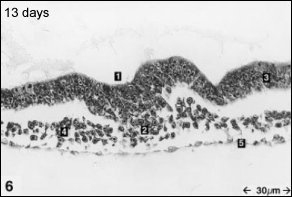
Something surprising happens: concentrations of mesodermal tissue, "somites", appear on either side of the neural crest, as a result of which the embryo is divided into identical structures. The embryo has an elongated shape and a rod-shaped structure across its middle, the notochord, the first skeletal element (the spinal cord in development). The number of somites increases.
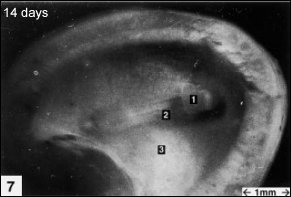
Dorsal and caudal (head and tail end) can be distinguished well, and already a tail is showing. The endoderm is folded as a tubular structure, the beginning of the gastrointestinal system. A primitive sort of blood circulation also develops.
At 15 to 17 days the cat's embryo is 2mm to 10mm big. The neural tube closes. The head is prominently present and slightly bent towards the caudal side of the embryo. Again, something surprising happens: the embryo develops gill arches, four in total in the cat. The primitive gastrointestinal system is ready and there is the beginning of a mouth. In the pharynx behind the mouth (the oesophagus) deep grooves develop that reach to the ectoderm. Later on, these will disappear again, but partly due to these gill arches, the thought arises that each embryo just repeats evolution. At the same time the cerebellum develops. It is already clear where the eyes and ears will be. The kitten has reached day 18 after the conception. At days 18 and 19 forelegs and hind legs develop. The cerebrum and brainstem are already present in a rudimentary form. The embryo is between 7mm and 18mm long, neck and tail are bent towards the trunk.
 |
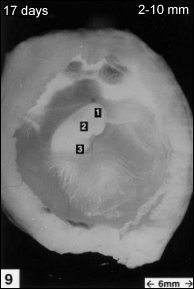 |
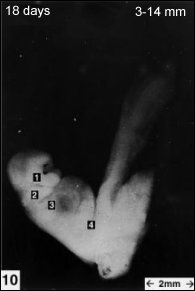 |
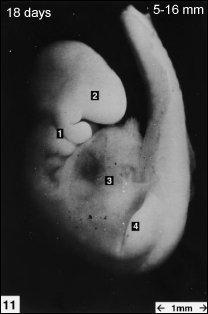 |
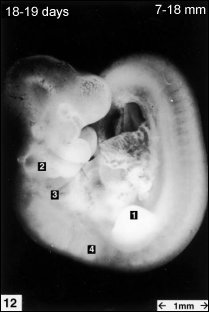 |
Everything happens quickly now. Until the 21st day the following things happen: the front gill arch (left and right) deepens itself and ultimately forms the auditory duct. The would-be eyes have a clear pigmentation and a duct for the olfactory organ deepens itself. The cerebellum is divided by a groove. The forelegs are now divided (as they are in the adult cat), with an internal skeleton, yet the hind legs are still primitive protuberances. The tail lengthens and is curled towards the body. Internally, veins differentiate for the blood circulation and nerves. The larynx, bronchi and lungs can also be discerned. Oesophagus, stomach and intestines are formed. Pancreas, thyroid gland, kidney and liver are also developed. On the side of the back, vertebrae are formed. The primitive spinal cord continues into the tail. Even the genital system is already present, albeit primitively.
The embryo is now 10mm to 24mm long. It may be clear that, especially in the early stages, people should be very careful with possible damaging substances. Vaccination with a live (attenuated) virus can be harmful to the embryo and also the use of, for example, remedies for fungi can be detrimental. Antibiotics are only to be administered if strictly necessary. Particularly Baytril should be avoided. Of course, the female cat's life takes precedence over the life of the kittens and naturally the female should only be mated if she is 100 percent healthy. But even pregnant cats can fall ill.
In the meantime the female cat shows signs that she is pregnant: her nipples become slightly larger and pinker than they were before. After 21 days, an experienced person can determine by way of palpation (a way of feeling and touching carefully) if the female cat is pregnant. At this stage, the foetuses are still so small (the size of a large pea), they can be distinguished among themselves and can therefore be counted. Some female cats suffer from morning sickness as a consequence of hormonal changes in their bodies.

Second trimester of the pregnancy
Over the next days (21 to 23 days) the upper lip is formed and eyelids begin to develop. Earlobes are formed. At the end of the legs, toes can be distinguished as a fan of dark matter against a lighter background. The genitalia are developed further. Internally, the skeleton and the muscles differentiate further and the ribs are formed, amongst others. The skeleton that is formed, still consists of cartilage. The face develops, tongue and palate are formed. Thyroid gland, parathyroid gland and heart develop, and an organ that most people at best only know as "sweetbread" from haute cuisine. The common biomedical term for sweetbread is thymus. This is situated in the chest cavity between the breast bone and the heart. The thymus has a central function in the immune system and is responsible for the production of so-called T-cells. If the thymus is absent in newborn animals, they produce hardly any antibodies at all and are therefore very susceptible to infections. But if the thymus is experimentally removed from animals (mice) when they are a few days old, these problems will not occur so much: the lymphocytes that are produced in the thymus and move on to the spleen and lymph glands, probably have already passed on the necessary information about what is foreign to spleen and lymph gland. The embryo now measures 13mm to 30mm.
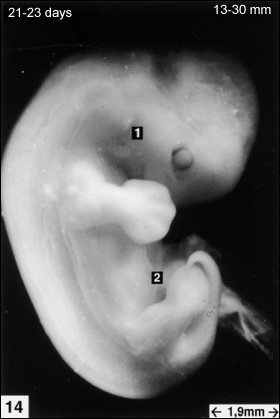
At 23 to 25 days, the toes of the foreleg, which were already visible, but still formed a lump, start to separate from each other. On the hind legs, which are a little behind in comparison with the forelegs, the would-be toes can be distinguished like a fan of dark matter against a lighter background, as happened before with the forelegs. Kidneys, adrenal glands and genitalia further differentiate. Within the primitive spinal cord, grey and white matter is separated and surrounded by a membrane. Grey matter mainly consists of nerve cells. The grey colour comes from the nucleus of those cells. White matter consists of attenuated nerve fibres, which contain a white, fatty substance, called "myelin". This white matter shrouds the grey matter in the spinal cord. Axons and ganglia differentiate. In the head the jaws, palate, tongue and salivary glands develop. Within the brain the pituitary gland forms itself, an important organ that produces several different hormones: Vasopressin, which is relevant to the body's water balance, Oxytocin, which plays a role at birth and afterwards at lactation and then a number of hormones involved with the regulation of other glands: thyroid-stimulating hormone (TSH), adrenocorticotropic hormone (ACTH), follicle-stimulating hormone (FSH) and luteinising hormone (LH), which both have an effect on the sex glands. In addition to this the pituitary gland also secretes growth hormone, which plays a very important, guiding role in the growth (of the young animal) as well as in its metabolism.
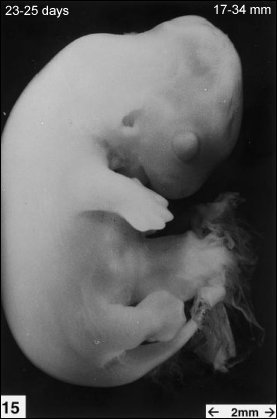
Stage 25 to 28 days, 21mm to 40mm. At this stage the embryos are in fact virtually complete mini cats and should rather be called foetuses. Everything develops further and differentiates even more. The head develops cheeks, a chin, a nose and a mouth. The area where the navel will be is reduced. The peritoneum, the pulmonary membrane and the diaphragm are formed. The carpal bones, toes and ribs are still cartilaginous, but are starting to calcify. The teeth are formed (hidden away in the jaw).

Things are beginning to take shape. The foetuses are now also growing rapidly and most "parts" are in their designated place. During the phase of 28 to 32 days, they are 25mm to 50mm big and it becomes difficult to determine the number of foetuses. Over the eye (that has been formed), an eyelid develops itself and there are small, triangular ears. The inner ear starts to differentiate into a complicated structure with which the animal can later hear; the eardrum is formed. On an image, the foetus already looks like a kitten. The ossification of several parts, still consisting of cartilage and where bone should usually be, goes on. The bronchi differentiate more and more. In female foetuses the womb develops. The liver, already present, is getting "lobed". The bladder develops. The size of the foetus is now 25mm to 50mm.

The foetuses keep on growing, the head is and will stay relatively big. The female cat now grows visually bigger, certainly if she carries multiple foetuses. We have now arrived at the period of 32 to 38 days. The size of the foetuses is now 35mm to 60mm. The skin feels smooth, there is no fur yet. The external genitalia are formed. The toes develop nails. The eye differentiates further, the iris is formed, amongst others.
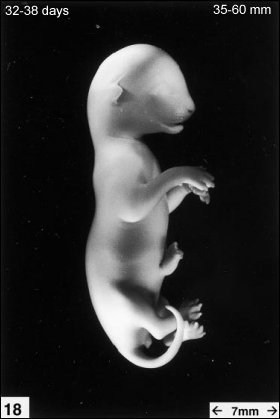
Third trimester of the pregnancy
From days 38 to 44 the skin differentiates. It becomes thicker and starts to wrinkle. The ears become bigger, the tail grows longer. The inner ear is formed, but is still of cartilage. The alveoli are developed. The pituitary gland becomes lobed. Within the intestines, intestinal villi are growing. The eyelids are complete and present, the eyes are closed. The embryo is 50mm to 80mm in size.
On day 44 the embryo measures 59mm to 94mm and fur is developing, the foetus is covered with a silky layer. From day 48 (65mm to 125mm), possible pigmentation is visible.
 |
 |
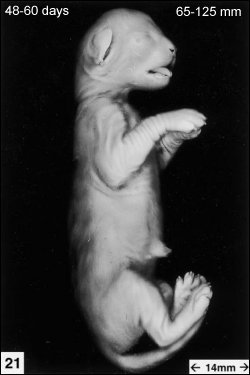 |
At last, the final stage from day 58 on. This is the stage just before birth. All organs are sufficiently fully-grown to make the foetus viable. A normal delivery takes places between 59 and 69 days after conception. Before day 59, the kittens will not yet be viable enough to survive without special medical help. If gestation lasts longer than 69 days, it will be wise to consult a vet. If the female cat does not mind that her temperature is taken rectally, you can take her temperature every morning: from 12 to 24 hours before delivery her temperature drops from its normal reading of 38.5 degrees Celsius to 37.5 degrees Celsius. A normal delivery starts with cervical dilation. The cat will produce some mucus from her vagina, but it is possible you will not notice this, because she will clean this up herself, if she is able to reach with her big belly. This stage can last up to 36 hours, especially with a primipare female cat (i.e. a female cat that has her first litter). It gets serious when she gets contractions. You can feel these strong contractions very well, when you place a hand on her belly. The most important thing you can do is: being there… Most female cats like it when you keep them company. Delivery of the first kitten often takes the longest. Do not panic too soon, just observe that the female cat stays calm. As long as the mother is not agitated or panicky, most of the time there is nothing going on. It is always pleasant, when both you and the female cat are inexperienced, to get support from an experienced breeder.
However, giving birth is something that is very natural and most of time no complications will happen. Still, it is wise to inform your vet about the approaching happy event. If you should need veterinary assistance, it is good to know who you can call (somehow, kittens like to be born in the middle of night...).

And if everything has gone well... Congratulations...
Sources
- C. Darwin. In The Origin of Species by Means of Natural Selection, or The Preservation of Favoured Races in the Struggle for Life, First Edition. Chapter 13: Mutual Affinities of Organic Beings: Morphology: Embryology: Rudimentary Organs.
- C. Knopse. Periods and Stages of the prenatal development of the domestic cat. Anat. Histol. Embryol. 31,37-51, 2002 Blackwell Wissenschafts-Verlag, Berlin, ISSN 0340-2096. PDF-file: http://www.vetmed.uni-muenchen.de/anat1/english/2002_ck1.pdf.
- C.H. WaddingtonGeorge Allen & Unwin LTD. Principles of Embryology. 1954.
Tube Feeding Kittens
By Lies Klösters, 2006.
With 'tube feeding', we mean feeding animals (or humans) by way of a catheter inserted via the mouth into the stomach. Fortunately, tube feeding is rarely necessary. Only when the animal is too weak to eat or suck on its own we need to resort to tube feeding. This can be the case with an older animal who is weakened by disease, or very young animals who don't yet have a suckle reflex. Also motherless newborns for whom no foster mom can be found, will often have to be raised with tube feeding.
Alternatives for tube feeding
If a kitten cannot be nursed by its own mother, then the best solution is to find a foster mom who is willing to take care of the kitten. However, suitable foster moms are mostly not available on a stand-by basis, and not every foster mom accepts kittens from another female. The second alternative is bottle feeding or tube feeding. Both these feeding methods feed the same milk formula. However, in the case of bottle feeding, the formula is not put directly into the stomach like with tube feeding. The kittens have to drink the milk from the bottle to receive their nourishment. Some disadvantages of bottle feeding compared to tube feeding are:
- Bottle feeding kittens is very time consuming. Tube feeding saves you a lot of time.
- Some kittens are messy eaters, which makes it difficult to determine exactly how much food they swallowed and how much they spilled.
- With bottle feeding, a kitten may choke. If enough formula ends up in the lungs, the kitten can drown. Even a small amount of formula in the lungs can cause pneumonia and be fatal.
Milk composition
Female mammals produce milk for their offspring. However, the composition of the milk varies per species. (See table 1). In general, smaller animals have a higher rate of metabolism than bigger animals. Since a small animal can only eat small amounts of food, but needs relatively more energy at the same time, their milk has to have a higher nutritional value. Therefor cow or goat milk (for example) is not suitable for kittens: cow and goat milk contains not enough fat. Dog milk, on the other hand, is much more similar to cat milk. Another problem may be the lactose level of milk: this differs widely between species and this may cause problems. Therefore it is better to use artificial milk (formula) to raise kittens. This formula has been especially developed for this purpose and will suit the nutritional needs of kittens much more than cow milk or goat milk.
The formula can be ordered from your local vet or through the Internet. There are also recipes available to make your own formula (this kind of kitten formula is also known as kitten glop). However, if you are not 100% sure what your kittens need, then don't make it yourself but buy the artificial milk.
| Species | Fat (%) |
Protein (%) |
Lactose (%) |
Ash (%) |
Total solids (%) |
| Rat | 14,8 | 11,3 | 2,9 | 1,5 | 31,7 |
| Cat | 10,9 | 11,1 | 3,4 | --- | 25,4 |
| Dog | 8,3 | 9,5 | 3,7 | 1,2 | 20,7 |
| Goat | 3,5 | 3,1 | 4,6 | 0,79 | 12 |
| Cow (Holstein) | 3,5 | 3,1 | 4,9 | 0,7 | 12,2 |
| Horse | 1,6 | 2,7 | 6,1 | 0,51 | 11 |
Table 1: Milk composition in a few mammals.
Source: Robert D. Bremel, University of Wisconsin; Handbook of Milk Composition by R.G. Jensen, Academic Press, 1995.
Tube feeding
We have made this information available in case that you -for whatever reason- need to tube feed your kittens.
Feeding tubes and syringes (for instance 3 or 4 cc) can be obtained from your local vet or through the Internet. Feeding tubes are available in different sizes: for kittens, small pups and large pups, but also for other species of animals.
The first time that you insert a tube, it will be awkward and difficult. It will get easier with practice. If it is possible, please let your vet (or someone who is familiar with tube feeding) show you how you should insert the catheter. Tube feeding is something that you definitely can learn to do yourself, you really don't need help of a vet at each feeding time.
The esophagus lies behind -more towards the spine than- the trachea. (See figure 1.) When inserting the tube, just let the tube slide to the back of the throat and administer light pressure, and it is hard to miss the esophagus. It works best when you dip the tube in a bit of water or the formula you want to give the kitten. This acts as a lubricant, and the taste of the formula will encourage the kitten to swallow the tube. Likely, the kitten will resist the insertion of the tube, but as it will also try to swallow the formula, and thus swallow the tube, the kitten itself will guide the tube into the esophagus and not into the trachea.
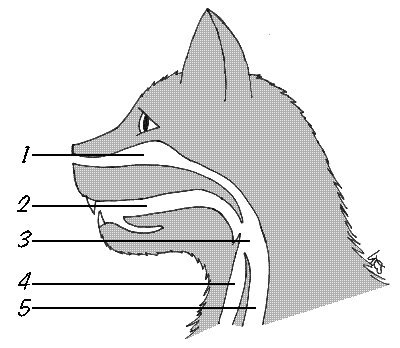
Figure 1: Cross section of the head of a cat.
1 = nasal cavity, 2 = oral cavity, 3 = pharynx, 4 = trachea, 5 = esophagus.
Before you insert the tube, measure how much of the tube should be inserted to reach the stomach. You can do this by holding the tube alongside the kitten, and measure the length of tube needed: this is the distance from the tip of the nose to the last rib. Use a piece of tape to mark the correct distance. The end of the tube is in the stomach when the marking has reached the mouth of the kitten. (See figure 2.)
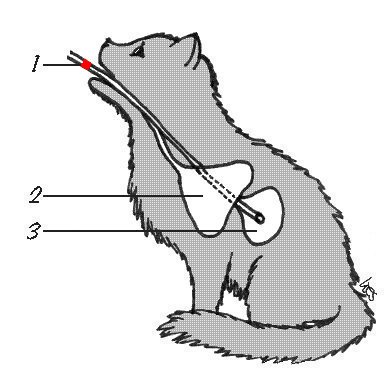
Figure 2: Cross section of the body of a cat.
1 = catheter with marking, 2 = lungs, 3 = stomach.
If by any chance the tube does start down into the trachea, the tube will not slide down up to the marking on the tube. The tube will not pass the point where the trachea divides into the bronchi, which lead to the two lungs. If the diameter of the tube that you use is too small, it might be possible to slide it past this division into the bronchi, so make sure the diameter of the tube that you use is correct. If the tube won't glide in until the marking reaches the mouth of the kitten, or if you feel any resistance, take the tube out and try it again.
If you still have doubts whether the tube is in the esophagus, then pull very gently on the syringe to see if you feel a vacuum creating. (Very gently please! You don't want to damage the wall of the esophagus.) The wall of the esophagus is very elastic and can be sucked onto the end of the tube. It then closes off the mouth of the tube, and you cannot suck any more air out: you will feel a vacuum. The wall of the trachea is not elastic like the wall of the esophagus, but it is rigid, made out of ring shaped cartilage and thus it will not be able to close off the end of the tube. Thus, you can continue to suck air out of the lungs of the kitten. So, please be careful!! Whether or not the opening of the tube can be closed off bij the wall of the trachea or esophagus, also depends on the kind of opening of the tube. With the opening in front of the tube, the wall of the esophagus will not be pulled against the tube as easily as when the tube has the opening slightly to the side. When you are sure the tube is placed correctly and the tip of the tube is in the stomach, calmly empty the syringe.
If the mother produce milk, but not enough (for example with a very big litter), some additional feeding might be all that is needed. Of course, mother's milk is the best nourishment kittens can get. As the mother is still feeding her litter, it is not necessary to feed all kittens with formula. It is best to feed the largest and heaviest kittens with formula, and not the smallest kittens. Especially the tiny kittens need the best milk, their mother's milk; the larger kittens will do just fine with some formula. When the larger kittens are satisfied, and have their stomach full with formula, the smaller kittens can nurse from their mom undisturbed. During the other feedings the larger kittens will make sure they get their share of the mother's milk anyway.
Handfed kittens are often also depending on you for the 'finishing touch'. The mother normally licks the area around the anus during and after the feeding of her kittens to stimulate defecation. Without this stimulus the kittens won't defecate. So don't expect that all you need to do is sit down and wait until the kittens pee and poop, and all you need to do is clean up after them. You will have to stimulate the kittens to defecate, simulating the way their mother would. Sometimes the mother has no milk but she still takes care of her babies. Then you are in luck: you feed the kittens, and mom does the rest.
Using a warm, wet wad of cotton wool can stimulate the kittens to defecate. Place this wad on the abdomen between the hind legs. Burning marks can occur when you rub the cotton wool over the skin, so keep the wad of cotton wool on it's place and make a circular motion with your index finger on the wad. Be sure to stimulate the kittens after each feeding! Remember, mom is none too gently herself! This procedure has been known to 'push' the balls out in little boys: this does no harm!
Newborns have to be fed every 4 hours, receiving 2 ml milk per feeding. After a week the time intervals between feedings and the amount of formula per feeding can be increased. Keep an eye on the weight of the kittens, this shows you whether or not the amount of formula and the number of feedings is sufficient for the kitten to grow. (A rough indication for normal growth is the doubling of the weight in the first week.)
Some tips:
- Make sure the formula is warm, very close to body temperature. This way the kittens don't have to waste valuable energy to regain their normal body temperature after a feeding of too cold milk, nor will they burn their mouth or esophagus when the milk was too hot. Kitten body temperature is around 38-39 degrees Celsius.
- Don't turn the kittens on their back during feeding, this isn't a natural posture. A kitten that is nursing with his mother won't lie on his back, but it will lie on his tummy or sit up straight.
- Insert the tube very gently and remove it quite rapidly, but not too fast as that will be painful. If the tube is removed too slowly there is a risk of some drops of formula that could leak from the tube and end up in the lungs.
- The tube can make breathing difficult, especially when the diameter is quite large. So don't leave the tube longer than strictly necessary in the kitten but remove it directly after the feeding.
- Always follow the instruction on the package of the formula you are using! By adding too much or too little water problems can arise.
Links to suppliers
Catstuff Online Shop - feeding tubes
Arcatapet - KMR Powder
Catstuff Online Shop - Kolostralmilch
Medi-Vet.com - Syringes
